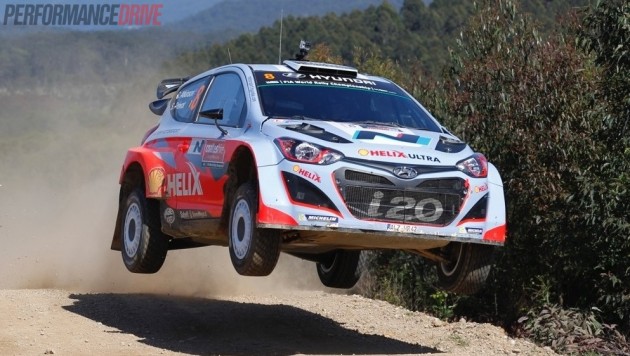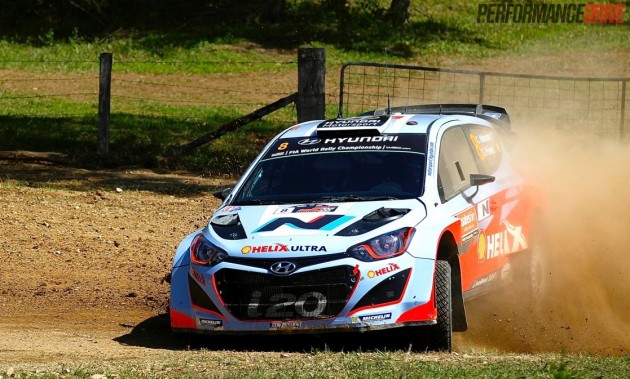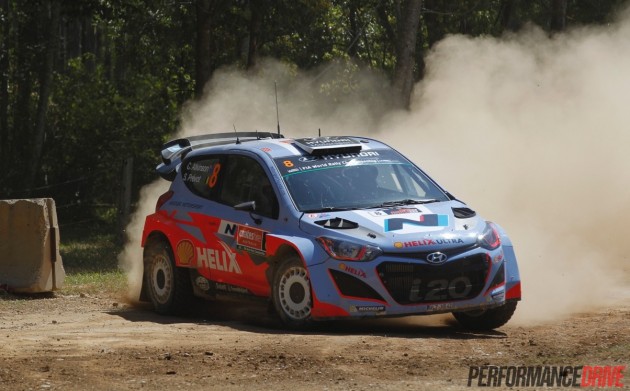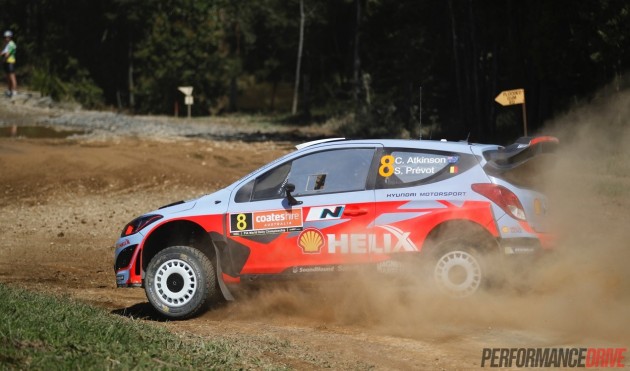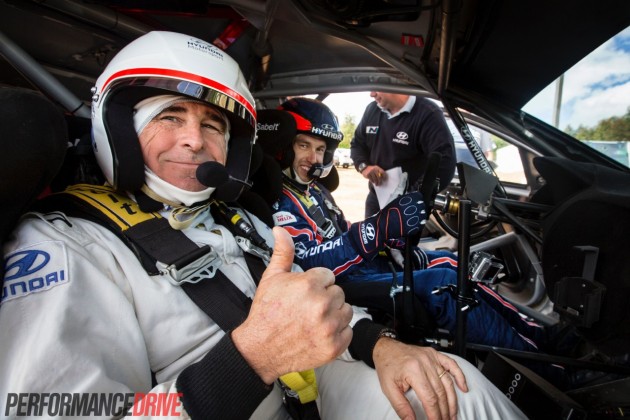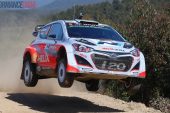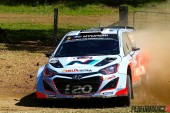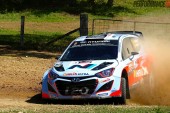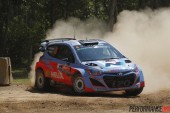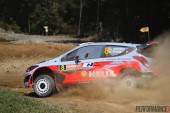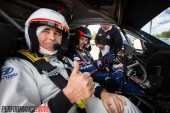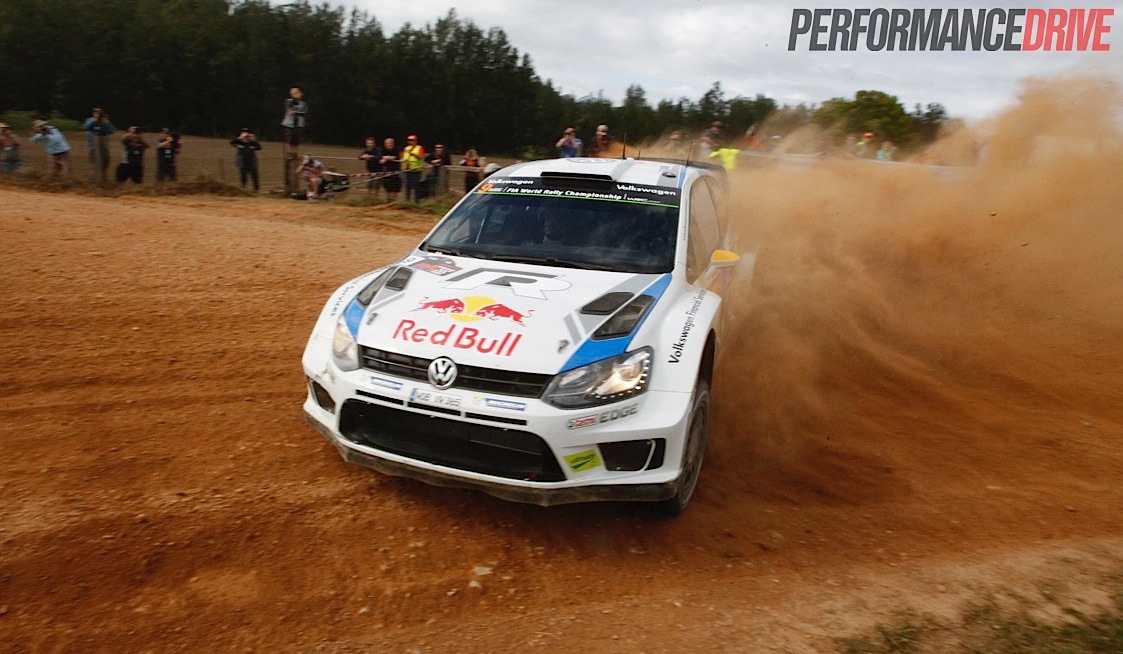Even for someone who has been involved in rallying for close to 35 years, or possibly because of that, it didn’t take this writer long to say yes when offered a ride in the latest World Rally Car, Hyundai’s i20 WRC, alongside Aussie driver Chris Atkinson.
The only thing faster than my acceptance would probably be these latest generation World Rally Cars. They are the Formula Ones of the forest, to use a hackneyed descriptor, even if the road is gravel, bumpy and has trees lining both sides.
The big leap forward for World Rally Cars in recent times has been the suspension. To be on the pace, and the Hyundai is only barely on the pace compared with the VWs and Citroens, these cars now sport massive front and rear coil-over shock absorbers with 300mm of travel, raked at a wild angle to gently cushion every bump and rebound.
Jumps can be taken flat out depending on the landing location and ruts and holes are like mere ripples on the forestry roads. This means that despite being slower in a straight line than the old 2.0-litre turbo WRCs, the new generation 1.6-litre cars are actually quicker in terms of stage times because they can carry so much more speed over and through everything.
Following a weekend covering Rally Australia at Coffs Harbour, PerformanceDrive was invited to climb aboard the WRC Hyundai for the chance to sample the speed, agility and sheer mind-blowing performance of this little 1.6-litre turbocharged, four-wheel drive alongside a bloke who truly knows how to exploit the limits of a rally car, Austrtalia’s Chris Atkinson.
Atko has been with Hyundai for the past year, as part of the test team in 2013 and so far competing in two rounds of the Korean maker’s first year back in the World Championship. It’s fair to say many are speculating about how long Chris will be with Hyundai after having so few outings this year and very little seat time at test sessions. So much so that it was difficult for him to get in the groove at Rally Oz and despite his best efforts could only manage tenth, a position way beneath his talent grade.
With the Hyundai team providing a driving suit, helmet and HANS device it was my turn to strap into the co-driver’s seat in the i20 and acquaint myself with the body-hugging Sabelt racing seat. A Hyundai worker straps me in the six-point harness cinched down hard, so much so that the car now felt part of me. Ahead of me is a smooth Alcantara trimmed dash with a phone cradle for normal co-driver Stefan Prevot, the distance measuring equipment was off to one side; equipment I would not need for my five kilometres in the right-hand seat.
On the other side of the cab, the suede covered racing wheel juts out from the dash allowing Atko to control the car from the seating position which is set back and low, virtually line astern with the B pillar and roll cage uprights for better weight distribution and balance. Directly in front of Chris, mounted just behind the wheel, is a computer screen similar in appearance to a shrouded iPad Mini, which delivers a variety of info to the driver depending on what he requires, which may be revs, or engine temp or a combination of various information and system monitors.
Chris fires up the engine and it barks loudly at its master’s command from the throttle. He engages first in the ‘dog box’ via the tall gear stick sitting just to his right alongside a similar long hand brake lever that allows him to pull the rear brakes on to pivot around corners. The dog box clunks loudly and he feeds in the clutch as we start rolling to the start line. Only 24 hours earlier the WRC field was tackling this very stage. It is very different watching from the inside of a WRC car compared with standing on the edge of the stage snapping photos.
On the start line Atko engages the launch program, the engine adopts a staccato rap as we prepare for blast off, then suddenly everything is unleashed, sensory overload comes rushing at you. The car accelerates to 100km/h on gravel in a shade over 4.0 seconds – about the same pace as a Ferrari 458 supercar on dry tarmac. Despite it being uphill and on loose gravel the Hyundai forces you back in the seat, the tyres biting down into the dirt, feeling as though it is overcoming every law of physics.
A tightening left-hander at the top of the ridge is taken almost flat after what seemed like a dozen quickchanges on the long sequential gear shifter, but in reality it was only three shifts up and now we are pitched into the next right-hander with the front right wheel apexing over the knarly roots of a large tree stump. Millimetre perfect placement by my pilot as the car rockets up the next uphill straight.
200 metres and a nanosecond later we crest a rise which is actually a ‘Yump’ and the car flies for a good 50 metres, over a metre off the deck and then lightly touches down as if it had never been airborne. Atko threads the Hyundai through a left-right-left complex of fast uphill bends, trees and rocks littered along the edges of the narrow forestry trail.
Bang, bang, bang the gear stick is cracked up through the gears into sixth for an instant and then it feels like a giant hand has grabbed the car’s roof slowing it rapidly, my shoulders hard against the harness as Atko Scandinavian flicks the car right and then hard left to head down hill. In an instant we are back in sixth and charging to another yump, flying even higher, the suspension soaking up the landing without a bounce. The car continues to accelerate down hill, Chris hard on the throttle as the road dips suddenly to the left, arcing downhill, across a broken gravel stretch, I glance across and realise we are in sixth gear close to the rev limiter.
It’s revealed later this equates to around 185km/h. The car tenaciously gripping the loose gravel, soaking up the bumps and rocks that have been torn from the surface by the passage of the entire Rally Australia field the day before.
The car is thrown to the right and then it’s hard on the brakes to take a 90 left at a tee junction. Atkinson pivots the Hyundai in its own length and then instantly back on the juice, up through the gearbox to the limit in sixth before hard on the brakes for the 90 left that completes the first of our two laps of the stage.
All the while Atkinson is talking in a manner so relaxed, so laid back that it is like chatting with a mate over a coffee at a cafe. Only, in reality, it’s chatting with someone throwing a million-dollar rally car around a dusty forest at well over 160km/h.
All too soon our second lap is over, a performance almost identical to the first lap down to a few microns. Atko slides the car through the final corner and slows to enter the compound where the Hyundai team is waiting. My senses are still in overload. I undo the harnesses, turn and look Atko in the eye and tell him with all sincerity that that was one of the best motorsport experiences of my life, thanking him for giving me a window on just how quick the current crop of WRC cars really are.
Hours later the experience is still replaying over in my head and the respect I have for the warriors of the forest swells to an even higher level. Let’s hope Chris Atkinson’s talent and speed aren’t squandered and lost to the WRC, and hope that we see him get more seat time and fulfill his real potential as a full-time driver on the World Stage.
For this writer it is time to ponder just how slow my Datsun Classic Rally car is by comparison to this high-tech Hyundai. The reality is, time never stands still in motorsport and evolution is a constant. I hate to imagine what World Rally Cars will be like even in five years time, but then again that is an exciting prospect… book me in for 2019 please.
Check out the video below to see how it all went.
